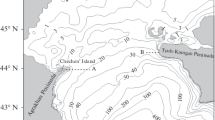Abstract
Luzon Strait, a wide channel between Taiwan and Luzon islands, connects the northern South China Sea and the Philippine Sea. The Kuroshio, South China Sea gyre, monsoon and local topography influence circulation in the Luzon Strait area. In addition, the fact that the South China Sea is a fairly isolated basin accounts for why its water property differs markedly from the Kuroshio water east of Luzon. This work applies a numerical model to examine the influence of the difference in the vertical stratification between the South China Sea and Kuroshio waters on the loop current of Kuroshio in the Luzon Strait during summer. According to model results, the loop current’s strength in the strait reduces as the strongly stratified South China Sea water is driven northward by the southwest winds. Numerical results also indicate that Kuroshio is separated by a nearly meridional ridge east of Luzon Strait. The two velocity core structures of Kuroshio can also be observed in eastern Taiwan. Moreover, the water flowing from the South China Sea contributes primarily to the near shore core of Kuroshio.
Similar content being viewed by others
References
Chao S. Y., P. T. Shaw and S. Y. Wu (1996): Deep water ventilation in the South China Sea.Deep Sea Res., I,43, 445–466.
Chern, C. S. and J. Wang (1994) Influence of the seasonal thermocline on the intrusion of Kuroshio across the continental shelf northeast of Taiwan.J. Oceanogr.,50, 691–711.
Chern, C. S. and J. Wang (1995): The seasonal variations of Kuroshio’s axis at east of Taiwan. 8th PAMS & JECSS Workshop, 26–28 September, Ehime University, Matsuyama, Japan.
Chu, T. Y. (1976): Study of the Kuroshio current between Taiwan and Ishigakijima.Acta Oceanogr. Taiwanica,6, 1–24.
Chuang, W. S. (1986): A note on the driving mechanisms of current in the Taiwan Strait.J. Oceanogr. Soc. Japan,42, 355–361.
Cushman-Roisin, B. (1986): Frontal geostrophic dynamics.J. Phys. Oceanogr.,16, 132–143.
Farris, A. and M. Wimbush (1996): Wind-induced Kuroshio intrusion into the South China Sea.J. Oceanogr.,52, 771–784.
Jan, S., C. S. Chern and J. Wang (1994): A numerical study on currents in the Taiwan Strait during summertime.La mer,32, 225–234.
Li, W., Q. Liu and S. P. Cheng (1996): The effect of break in western boundary on the western boundary current.Acta Oceanogr. Taiwanica,35(2), 141–153.
Liu, C. T., Y. Yang, S. P. Cheng, C. S. Wang and Q. Liu (1995): The counter current southeast of Lanyu Island.Acta Oceanogr. Taiwanica,34(1), 41–56.
Matsuura, T. and T. Yamagata (1982): On the evolution of nonlinear planetary eddies larger than the radius of deformation.J. Phys. Oceanogr. 12, 440–456.
Merkine, L. and E. Kalnay-Rivas (1976): Rotating stratified flow over finite isolated topography.J. Atmos. Sci. 33, 908–922.
Nitani, H. (1972): Beginning of the Kuroshio. p. 129–163. InKuroshio, University of Washington Press, Seattle, WA.
Semtner, A. J. (1974): An oceanic general circulation model with bottom topography. Numerical Simulation of Weather and Climate, Tech. Rep. 9, Dept. of Meterology, UCLA, 99 pp.
Semtner, A. J. (1986): Finite difference formulation of a world ocean model. InProceedings of the NATO Advanced Study Institute on Advanced Physical Oceanographic Numerical Modelling, ed. by J. J. O’Brien, D. Reidel Publishing Co. Dordrecht, 608 pp.
Shaw, P. T. and S. Y. Chao (1994) Surface circulation in the South China Sea.Deep Sea Res., I,41, 1663–1683.
Shaw, P. T., S. Y. Chao, K. K. Liu, S. C. Pai and C. T. Liu (1996): Winter upwelling off Luzon in the northern South China Sea.J. Geophys. Res.,101, C7, 16435–16448.
Wang, J. and C. S. Chern (1987): The warm-core eddy in the northern South China Sea, I. Preliminary observations on the warm-core eddy.Acta Oceanogr. Taiwanica,18, 92–103.
Wang, J. and C. S. Chern (1996): Some aspects on the circulation in the northern South China Sea.La mer,34(3), 246–257.
Wyriki, K. (1961): Physical oceanography of the Southeast Asian waters. NAGA Report, 2, Scientific Results of Marine Investigations of the South China Sea and the Gulf of Thailand, Scripps Institution of Oceanography, La Jolla, California, 195 pp.
Author information
Authors and Affiliations
Rights and permissions
About this article
Cite this article
Chern, CS., Wang, J. A numerical study of the summertime flow around the Luzon Strait. J Oceanogr 54, 53–64 (1998). https://doi.org/10.1007/BF02744381
Received:
Revised:
Accepted:
Issue Date:
DOI: https://doi.org/10.1007/BF02744381




